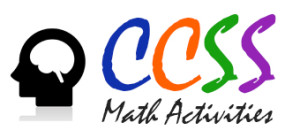HS Performance Tasks
Students will be asked to show equivalent expressions in function form. They will use those equivalent expressions to determine information about the context of the problem. Additionally, they will determine when it is best to use a certain function form for specific reasons. Finally, students will have an opportunity to write equivalent expressions.
Source: The Charles A. Dana Center, University of Texas at Austin
Students will write a system of equations to solve a problem. Using those equations, students will figure out total numbers of items sold. Finally, students will use prior knowledge of percentages to calculate profits and make a recommendation for the selling price of an item.
Source: SMc Curriculum
Students will be asked to graph points to determine if a function is linear or non-linear. Once a graph is drawn, students will be asked to interpret the graph and make predictions from it. Additionally, students will be asked to use information from a table to determine characteristics of the graph.
Source: CT Core Standards
Students will practice writing exponential functions in this task. Once their function is written, students are tasked with using the function to evaluate given certain numbers. Finally, students are asked to use their function to determine the validity of numbers.
Source: Illustrative Math
Students will be asked to write a linear equation. They will then use that linear equation to find a point of intersection with a quadratic equation. Different forms of a quadratic will be presented and students will be asked to show their equivalency and find key information from the different forms.
Source: Howard County Public Schools
Students will use trigonometry and properties of circles and triangles to find distances. Additionally, students will be able to practice with the Pythagorean theorem. Lastly, students will use a drawing to make a conclusion about the shortest distance between points.
Source: The Charles A. Dana Center, University of Texas at Austin
Students will be asked to calculate the probability of simple and compound events. Probabilities will be given and students will be asked to explain if those probabilities are correct or incorrect. Finally, students will be asked to use their knowledge of probability to make a recommendation regarding a game.
Source: The Charles A. Dana Center, University of Texas at Austin
Students are presented with information about the dimensions of an actual Ferris wheel. They must come up with a model for the height of a cart on the Ferris wheel at particular times. The task requires students to use a function that they create to determine the height of a person at particular times.
Source: NYC Department of Education
Students will be asked to find the volume of spheres and cylinders. Using the volumes, students will determine whether or not items will fit into containers. Finally, students will reason about the volume of other containers based on their knowledge of given containers.
Source: SMc Curriculum
Students will investigate number patterns. They will write equations or rules from those number patterns. Using the equations they created, students will determine the number of shapes in a pattern. Finally, students will create their own pattern given certain parameters.
Source: Mathematics Assessment Resource Service (MARS)





